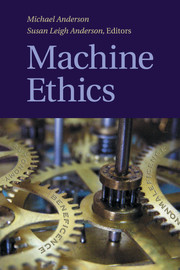Book contents
- Frontmatter
- Contents
- General Introduction
- PART I THE NATURE OF MACHINE ETHICS
- PART II THE IMPORTANCE OF MACHINE ETHICS
- PART III ISSUES CONCERNING MACHINE ETHICS
- PART IV APPROACHES TO MACHINE ETHICS
- Introduction
- 14 Towards the Ethical Robot
- 15 Asimov's Laws of Robotics
- 16 The Unacceptability of Asimov's Three Laws of Robotics as a Basis for Machine Ethics
- 17 Computational Models of Ethical Reasoning
- 18 Computational Neural Modeling and the Philosophy of Ethics
- 19 Architectures and Ethics for Robots
- 20 Piagetian Roboethics via Category Theory
- 21 Ethical Protocols Design
- 22 Modeling Morality with Prospective Logic
- 23 An Integrated Reasoning Approach to Moral Decision Making
- 24 Prototyping N-Reasons
- 25 There Is No “I” in “Robot”
- 26 Prospects for a Kantian Machine
- 27 A Prima Facie Duty Approach to Machine Ethics
- PART V VISIONS FOR MACHINE ETHICS
- References
27 - A Prima Facie Duty Approach to Machine Ethics
Machine Learning of Features of Ethical Dilemmas, Prima Facie Duties, and Decision Principles through a Dialogue with Ethicists
from PART IV - APPROACHES TO MACHINE ETHICS
Published online by Cambridge University Press: 01 June 2011
- Frontmatter
- Contents
- General Introduction
- PART I THE NATURE OF MACHINE ETHICS
- PART II THE IMPORTANCE OF MACHINE ETHICS
- PART III ISSUES CONCERNING MACHINE ETHICS
- PART IV APPROACHES TO MACHINE ETHICS
- Introduction
- 14 Towards the Ethical Robot
- 15 Asimov's Laws of Robotics
- 16 The Unacceptability of Asimov's Three Laws of Robotics as a Basis for Machine Ethics
- 17 Computational Models of Ethical Reasoning
- 18 Computational Neural Modeling and the Philosophy of Ethics
- 19 Architectures and Ethics for Robots
- 20 Piagetian Roboethics via Category Theory
- 21 Ethical Protocols Design
- 22 Modeling Morality with Prospective Logic
- 23 An Integrated Reasoning Approach to Moral Decision Making
- 24 Prototyping N-Reasons
- 25 There Is No “I” in “Robot”
- 26 Prospects for a Kantian Machine
- 27 A Prima Facie Duty Approach to Machine Ethics
- PART V VISIONS FOR MACHINE ETHICS
- References
Summary
In our early work on attempting to develop ethics for a machine, we first established that it is possible to create a program that can compute the ethically correct action when faced with a moral dilemma using a well-known ethical theory (Anderson et al. 2006). The theory we chose, Hedonistic Act Utilitarianism, was ideally suited to the task because its founder, Jeremy Bentham (1781), described it as a theory that involves performing “moral arithmetic.” Unfortunately, few contemporary ethicists are satisfied with this teleological ethical theory that bases the rightness and wrongness of actions entirely on the likely future consequences of those actions. It does not take into account justice considerations, such as rights and what people deserve in light of their past behavior; such considerations are the focus of deontological theories like Kant's Categorical Imperative, which have been accused of ignoring consequences. The ideal ethical theory, we believe, is one that combines elements of both approaches.
The prima facie duty approach to ethical theory, advocated by W.D. Ross (1930), maintains that there isn't a single absolute duty to which we must adhere, as is the case with the two aforementioned theories, but rather a number of duties that we should try to follow (some teleological and others deontological), each of which could be overridden on occasion by one of the other duties.
- Type
- Chapter
- Information
- Machine Ethics , pp. 476 - 492Publisher: Cambridge University PressPrint publication year: 2011
References
- 21
- Cited by



